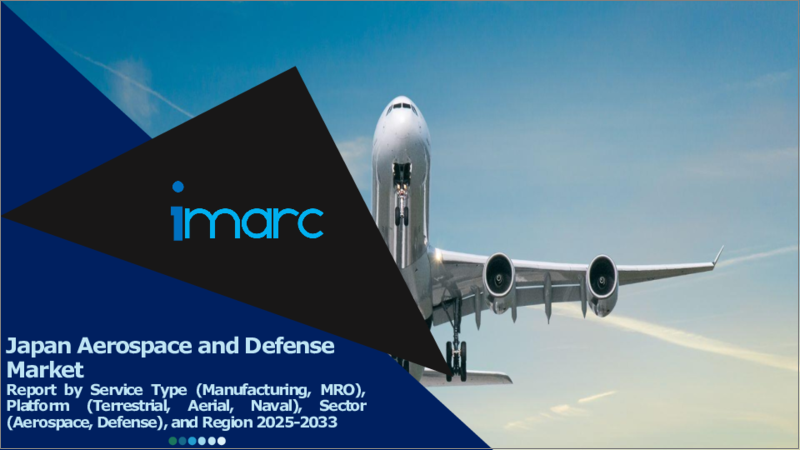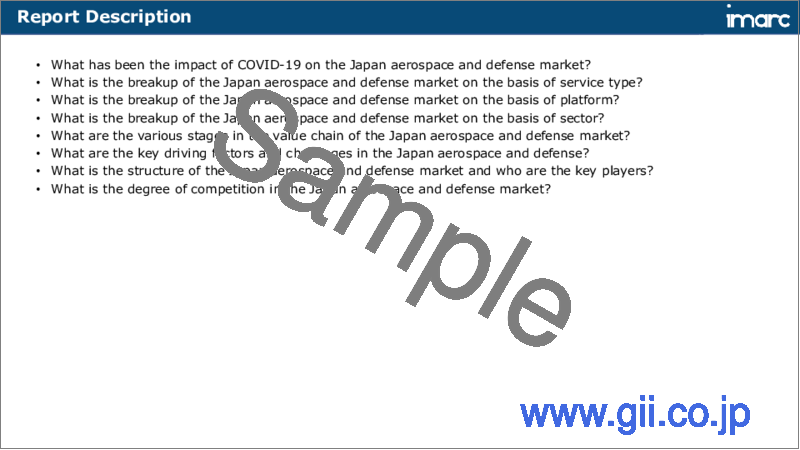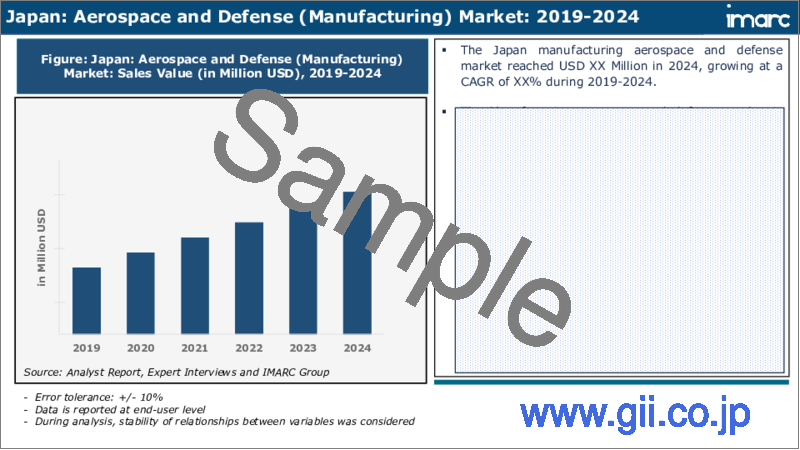|
|
市場調査レポート
商品コード
1609911
日本の航空宇宙および防衛市場レポート:サービスタイプ、プラットフォーム、セクター、地域別、2025年~2033年Japan Aerospace and Defense Market Report by Service Type (Manufacturing, MRO), Platform (Terrestrial, Aerial, Naval), Sector (Aerospace, Defense), and Region 2025-2033 |
||||||
カスタマイズ可能
|
|||||||
| 日本の航空宇宙および防衛市場レポート:サービスタイプ、プラットフォーム、セクター、地域別、2025年~2033年 |
|
出版日: 2024年12月05日
発行: IMARC
ページ情報: 英文 117 Pages
納期: 5~7営業日
|
全表示
- 概要
- 目次
日本の航空宇宙および防衛市場の市場規模は2024年に550億米ドルに達しました。IMARC Groupは、2025年から2033年にかけての成長率(CAGR)は4.6%で、2033年には824億米ドルに達すると予測しています。国家安全保障と領土主権に関する政府機関の懸念の高まり、通信、監視、科学的調査を促進する宇宙船と衛星技術の継続的な進歩は、市場成長を促進する主な要因の一部です。
本レポートで扱う主な質問
- 日本の航空宇宙および防衛市場はこれまでどのように推移してきたか、また今後どのように推移していくのか?
- 日本の航空宇宙および防衛市場へのCOVID-19の影響は?
- 日本の航空宇宙および防衛市場のサービスタイプ別の内訳は?
- 日本の航空宇宙および防衛市場のプラットフォーム別の内訳は?
- 日本の航空宇宙および防衛市場のセクター別の内訳は?
- 日本の航空宇宙および防衛市場のバリューチェーンにはどのような段階がありますか?
- 日本の航空宇宙および防衛分野における主な促進要因と課題は何か?
- 日本の航空宇宙および防衛市場の構造と主要プレーヤーは?
- 日本の航空宇宙および防衛市場における競合の程度は?
目次
第1章 序文
第2章 調査範囲と調査手法
- 調査の目的
- ステークホルダー
- データソース
- 市場推定
- 調査手法
第3章 エグゼクティブサマリー
第4章 日本の航空宇宙および防衛市場:イントロダクション
- 概要
- 市場力学
- 業界動向
- 競合情報
第5章 日本の航空宇宙および防衛市場情勢
- 過去および現在の市場動向(2019年~2024年)
- 市場予測(2025-2033)
第6章 日本の航空宇宙および防衛市場:サービスタイプ別の内訳
- 製造
- MRO
第7章 日本の航空宇宙および防衛市場:プラットフォーム別の内訳
- 陸上
- 航空
- 海軍
第8章 日本の航空宇宙および防衛市場:セクター別内訳
- 航空宇宙
- 防衛
第9章 日本の航空宇宙および防衛市場:競合情勢
- 概要
- 市場構造
- 市場プレーヤーのポジショニング
- 主要成功戦略
- 競合ダッシュボード
- 企業評価象限
第10章 主要企業のプロファイル
第11章 日本の航空宇宙および防衛市場:業界分析
- 促進要因・抑制要因・機会
- ポーターのファイブフォース分析
- バリューチェーン分析
第12章 付録
Japan aerospace and defense market size reached USD 55.0 Billion in 2024. Looking forward, IMARC Group expects the market to reach USD 82.4 Billion by 2033, exhibiting a growth rate (CAGR) of 4.6% during 2025-2033. The rising apprehensions among government agencies regarding national security and territorial sovereignty and continuous advancements in spacecraft and satellite technologies to facilitate communication, surveillance, and scientific inquiry are some of the primary drivers propelling the market growth.
The aerospace and defense sector is a multifaceted domain encompassing the development and application of aircraft and weaponry specifically designed for the facilitation of aerial transportation and the provision of national security. It includes entities that manufacture and maintain spacecraft and related systems and equipment used for both civilian and military purposes. In aerospace, the applications range from commercial airliners to drones, enabling travel, cargo transport, and various aerial services. The defense sector develops advanced weaponry, military aircraft, and missile systems, providing nations with the capabilities to defend against threats. It plays a pivotal role in securing countries and maintaining peace and order by equipping armed forces with the necessary tools and technologies. Furthermore, the defense and aerospace industry stimulates economic growth, thus creating jobs and highlighting its integral role in both technological progression and geopolitical stability.
Japan Aerospace and Defense Market Trends:
The Japan aerospace and defense market is undergoing remarkable innovations, propelled by emerging trends and notable drivers. One of the primary factors is the rising adoption of cutting-edge technologies, including Artificial Intelligence (AI), robotics, and optimal materials, to enhance the capabilities and performance of aerospace and defense equipment. These advancements are fostering the development of more efficient, reliable, and sophisticated systems, which are crucial in modern warfare and aviation. Another significant driver for this market is the escalating concerns among government bodies towards territorial integrity. Moreover, the ongoing pursuit of space exploration and satellite deployment to support communication, surveillance, and scientific research is another trend shaping the regional market. Besides this, the elevating need for self-reliance to reduce dependencies on foreign entities for critical technologies and equipment is also a notable factor, thereby propelling several initiatives to strengthen the domestic aerospace and defense industry. Apart from this, the rising emphasis on sustainable and eco-friendly innovations is gaining traction, reflecting the aerospace industry's commitment to mitigate environmental impacts while advancing in technological prowess and strategic capabilities. This, in turn, is anticipated to bolster the market growth in Japan over the forecasted period.
Japan Aerospace and Defense Market Segmentation:
Service Type Insights:
- Manufacturing
- MRO
Platform Insights:
- Terrestrial
- Aerial
- Naval
Sector Insights:
- Aerospace
- Defense
Competitive Landscape:
The market research report has also provided a comprehensive analysis of the competitive landscape. Competitive analysis such as market structure, key player positioning, top winning strategies, competitive dashboard, and company evaluation quadrant has been covered in the report. Also, detailed profiles of all major companies have been provided. Some of the key players include:
- Kawasaki Heavy Industries Ltd.
- Lockheed Martin Corporation
- Mitsubishi Heavy Industries Ltd.
- Northrop Grumman Corporation
- ShinMaywa Industries Ltd.
- Thales Group
Key Questions Answered in This Report:
- How has the Japan aerospace and defense market performed so far and how will it perform in the coming years?
- What has been the impact of COVID-19 on the Japan aerospace and defense market?
- What is the breakup of the Japan aerospace and defense market on the basis of service type?
- What is the breakup of the Japan aerospace and defense market on the basis of platform?
- What is the breakup of the Japan aerospace and defense market on the basis of sector?
- What are the various stages in the value chain of the Japan aerospace and defense market?
- What are the key driving factors and challenges in the Japan aerospace and defense?
- What is the structure of the Japan aerospace and defense market and who are the key players?
- What is the degree of competition in the Japan aerospace and defense market?
Table of Contents
1 Preface
2 Scope and Methodology
- 2.1 Objectives of the Study
- 2.2 Stakeholders
- 2.3 Data Sources
- 2.3.1 Primary Sources
- 2.3.2 Secondary Sources
- 2.4 Market Estimation
- 2.4.1 Bottom-Up Approach
- 2.4.2 Top-Down Approach
- 2.5 Forecasting Methodology
3 Executive Summary
4 Japan Aerospace and Defense Market - Introduction
- 4.1 Overview
- 4.2 Market Dynamics
- 4.3 Industry Trends
- 4.4 Competitive Intelligence
5 Japan Aerospace and Defense Market Landscape
- 5.1 Historical and Current Market Trends (2019-2024)
- 5.2 Market Forecast (2025-2033)
6 Japan Aerospace and Defense Market - Breakup by Service Type
- 6.1 Manufacturing
- 6.1.1 Overview
- 6.1.2 Historical and Current Market Trends (2019-2024)
- 6.1.3 Market Forecast (2025-2033)
- 6.2 MRO
- 6.2.1 Overview
- 6.2.2 Historical and Current Market Trends (2019-2024)
- 6.2.3 Market Forecast (2025-2033)
7 Japan Aerospace and Defense Market - Breakup by Platform
- 7.1 Terrestrial
- 7.1.1 Overview
- 7.1.2 Historical and Current Market Trends (2019-2024)
- 7.1.3 Market Forecast (2025-2033)
- 7.2 Aerial
- 7.2.1 Overview
- 7.2.2 Historical and Current Market Trends (2019-2024)
- 7.2.3 Market Forecast (2025-2033)
- 7.3 Naval
- 7.3.1 Overview
- 7.3.2 Historical and Current Market Trends (2019-2024)
- 7.3.3 Market Forecast (2025-2033)
8 Japan Aerospace and Defense Market - Breakup by Sector
- 8.1 Aerospace
- 8.1.1 Overview
- 8.1.2 Historical and Current Market Trends (2019-2024)
- 8.1.3 Market Forecast (2025-2033)
- 8.2 Defense
- 8.2.1 Overview
- 8.2.2 Historical and Current Market Trends (2019-2024)
- 8.2.3 Market Forecast (2025-2033)
9 Japan Aerospace and Defense Market - Competitive Landscape
- 9.1 Overview
- 9.2 Market Structure
- 9.3 Market Player Positioning
- 9.4 Top Winning Strategies
- 9.5 Competitive Dashboard
- 9.6 Company Evaluation Quadrant
10 Profiles of Key Players
- 10.1 Kawasaki Heavy Industries Ltd.
- 10.1.1 Business Overview
- 10.1.2 Services Offered
- 10.1.3 Business Strategies
- 10.1.4 SWOT Analysis
- 10.1.5 Major News and Events
- 10.2 Lockheed Martin Corporation
- 10.2.1 Business Overview
- 10.2.2 Services Offered
- 10.2.3 Business Strategies
- 10.2.4 SWOT Analysis
- 10.2.5 Major News and Events
- 10.3 Mitsubishi Heavy Industries Ltd.
- 10.3.1 Business Overview
- 10.3.2 Services Offered
- 10.3.3 Business Strategies
- 10.3.4 SWOT Analysis
- 10.3.5 Major News and Events
- 10.4 Northrop Grumman Corporation
- 10.4.1 Business Overview
- 10.4.2 Services Offered
- 10.4.3 Business Strategies
- 10.4.4 SWOT Analysis
- 10.4.5 Major News and Events
- 10.5 ShinMaywa Industries Ltd.
- 10.5.1 Business Overview
- 10.5.2 Services Offered
- 10.5.3 Business Strategies
- 10.5.4 SWOT Analysis
- 10.5.5 Major News and Events
- 10.6 Thales Group
- 10.6.1 Business Overview
- 10.6.2 Services Offered
- 10.6.3 Business Strategies
- 10.6.4 SWOT Analysis
- 10.6.5 Major News and Events
11 Japan Aerospace and Defense Market - Industry Analysis
- 11.1 Drivers, Restraints, and Opportunities
- 11.1.1 Overview
- 11.1.2 Drivers
- 11.1.3 Restraints
- 11.1.4 Opportunities
- 11.2 Porters Five Forces Analysis
- 11.2.1 Overview
- 11.2.2 Bargaining Power of Buyers
- 11.2.3 Bargaining Power of Suppliers
- 11.2.4 Degree of Competition
- 11.2.5 Threat of New Entrants
- 11.2.6 Threat of Substitutes
- 11.3 Value Chain Analysis






